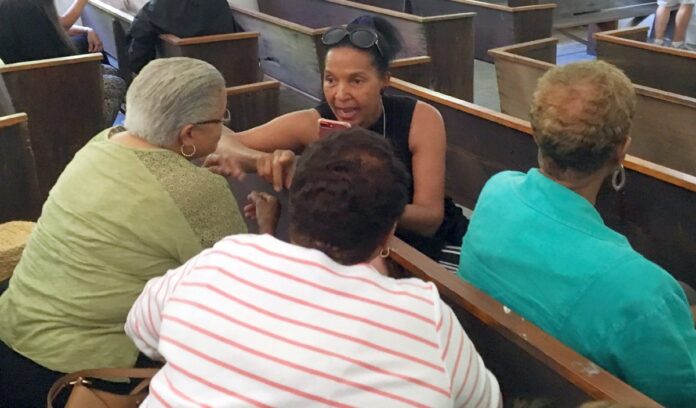
CARTHAGE — It rested on boulders. Some wondered if a storm would one day take out the mid-1800s structure, a remaining tie to their ancestors and the setting for decades of homecoming service memories.
Yet whenever Priscilla Phelps came out to check, the Beech Church was still standing.
“God seemed to protect it,” she said while chatting with friends gathered at the church on last Saturday.
[sc:text-divider text-divider-title=”Story continues below gallery” ]Click here to purchase photos from this gallery
About 50 people gathered celebrate the renovation of Beech Church, named in 2016 to Indiana Landmarks’ 10 Most Endangered list. The open house was the culmination of years of advocacy and fundraising and of about 10 months of renovation at the site. It was followed on Sunday by the annual homecoming service that takes place at the church.
Each year, Phelps and other descendants of the Beech Settlement, along with friends of the group, worship God together and remember the free black people who settled in the Carthage area in the 1820s.
“It’s my family,” said James D. Cornett II. “It’s a part of my life.”
He went to his earliest homecoming services as a child.
“Everyone would sit and talk about old times and eat a lot of good food,” he said.
The family moved around because of his father’s military career, and Cornett said coming back to reunions gave him good “what I did this summer” stories — stories that Cornett, a former professor at the University of Indianapolis and Ferris State University in Michigan, now realizes were educating others.
“I was able to bring back some history that other students didn’t have,” he said.
Dennis Archey of New Castle was also among the descendants at the church Saturday to see the change in the building.
“It was pretty much on its last legs,” he said. “I was really shocked by how well they’ve done … I like it.
“The older you get, the more you appreciate what happened (in the past).”
Some who came to see the newly renovated church on Saturday brought history of their Beech Settlement ancestors. Others carried the history of the people who welcomed them, Quaker settlers who were known to be hospitable to them.
Janet Shutt is a descendant of Quaker settlers in the area. They were part of the nearby Friends churches at Mt. Pleasant and Walnut Ridge, with the latter church remaining today.
She remembers her grandfather, Elmer Hunt, saying, “Janet, thee must go with me to the Beech.” She went to her earliest homecoming services at 4 or 5 years old. Used to a quieter worship style in the Quaker church, she responded to the louder, jubilant music of Beech homecomings by clinging to Hunt’s pantleg while he held her hand.
But she grew to appreciate the services and love the people there. Today she is grateful for those early influences from her ancestors.
“I am so thankful,” she said. “They have made such a difference in how I relate to people.”
Shutt is a member of the Beech Settlement Board that looks after the site. During the Indiana State Fair, board members went to a ceremony inducting the church and cemetery site into the Indiana Register of Historic Sites and Structures.
The church structure once rested on a foundation of boulders. Crews lifted it, replaced damaged wooden sills on the bottom, and built a foundation underneath before lowering it back into place. Fresh white paint, a new cross a neighbor built from area beech trees, and new windows and steps are part of the church’s “new” look. Historic pews remain but were reinforced. Those gathered said the renovation stays true to the longtime look of the setting.
“We just wanted to keep the integrity of the building,” said Pat Jones. “We were so pleased.”
Her late husband, Douglas Jones — Phelps’ brother — was among those working toward the restoration. When he died in 2017, she asked people to consider donating to the restoration instead of sending flowers.
“This was his dream,” Pat Jones said. “He’s smiling down, I know, today.”
Beech descendant Susan Boatright also remembered those who have worked to preserve the history of the settlement. She came to her first homecoming service when she was about 2 weeks old; her late mother, Gladys Boatright, once led the crew cleaning up the church for the homecoming.
Resting on those boulders, “the church was tipping,” Susan Boatright said. But she says she didn’t worry about the church being knocked down.
“There’s a deep faith and knowledge about this place that goes far beyond financial distress,” she said. “There’s a deep love and sense of commitment and remembrance to the people who brought us here.
“The descendants continue to roll through here. We will not let this fail.”



